It looks like you're using an Ad Blocker.
Please white-list or disable AboveTopSecret.com in your ad-blocking tool.
Thank you.
Some features of ATS will be disabled while you continue to use an ad-blocker.
share:
I first came across this incredibly interesting discovery while reading about the Comalcalco stone associated with the second known reference
supposedly to 2012 that has been announced by the National Institute of Anthropology and History recently,you can find that thread
hereMexico Acknowledges 2nd Mayan Reference to 2012 if interested.
So while researching the Comalcalco stone I stumbled upon something that surprised and caught my attention immediately,that was the archeological finding of thousands of bricks that were engraved with inscriptions & languages that were not native to Meso-America at the time and do not belong there as history & other archeological findings in the region would have us believe!
So started my research to dig deeper and what follows is what I've been able to gather & decipher so far ,I will start from the beginning,so as to give some background information on the discovery-
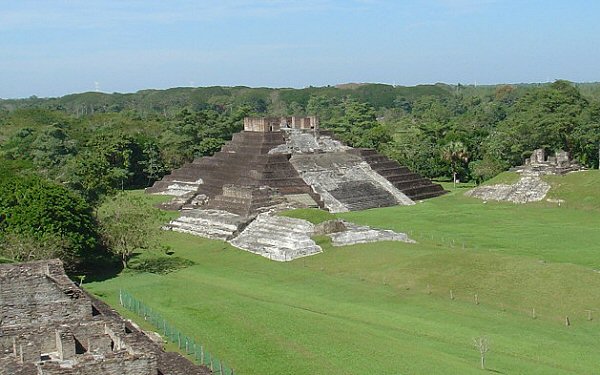
Comalcalco Temple one

Top of Temple one
Comalcalco is a Mayan site surrounded by a rain forest in the Mexican state of Tabasco,It is the only Meso-American city constructed of fired bricks. (I will get to exactly what "fired bricks" are and where the process originated a little later) These ruins contain 372 mounds covering 40 sq. kilometers;so far only four of the 372 mounds have been completely excavated and they have revealed an acropolis,seven temples,two palaces,two structures and 20-30 tombs.
Found within these mounds were thousands of fired bricks that held inscriptions depicting animals,people,plants,houses,temples,ships,letters and sacred symbols but surprisingly many had Mediterranean elements with two even showing elephants!
In the early 1960's a preliminary site survey it was revealed two bricks with inscriptions on them.Afterwards between the years 1975-1978 Mexican archeologist Pancio Salazar,at the time working for the national institute of anthropology & history of Mexico (I.N.A.H) continued more excavations discovering forty six hundred inscribed bricks that were later examined.
Most of the inscriptions were recognizable as Mayan hieroglyphs.but a few turned out to be completely different,causing excitement and speculation.It was not until 1980 after Salazars death that the collection of bricks were photographed & cataloged by archeologist & epigrapher Neil Steede.
Steede showed the photos to professor Barry Fell then leader & founder of 'the epigraphic society'.
Fell went onto publish a series of papers on the subject of the bricks for ESOP (The epigraphic society occasional papers) 'the Comalcalco bricks:part 1,the Roman phase' (published in Vol. 19)
Fell drew attention to what he called "Mason's Marks"out of the forty six hundred bricks examined,fifteen hundred were marked in this way.
What was so interesting about these marks was their striking similarity to Roman mason's marks found on similar bricks in Britain among other places.The Romans used these marks to keep a tally of individual productivity and slaves.
Each of their quarry slaves were required to produce close to two hundred bricks a day,by marking the bricks each slave made with his personal symbol,the slave could prove he was working at full speed.
Also it is believed that The Roman bricks are often stamped with the mark of the legion that supervised their production.
Source
Here are some examples of the engravings that were found on the bricks-

Mason marks seen on Comalcalco’s bricks (left) strongly resemble those used by Roman masons (right).

Christian motifs common in ancient Europe (top) are similar to motifs at Comalcalco (bottom).
Source [ Fig. 5/16.5.17 ]

Masons' marks from Roman sites (left) and Comalcalco (right) (Fell,Barry 1990)
Source
Additional links concerning 'Mason marks'-
Link
The diagram compares some of the marks found at Comalcalco (on the right) with those found at Roman sites (on the left). The similarities are truly amazing!
Additional links concerning 'Mason marks'-
Link
Source
Source
Mediterranean looking ceramic heads found at Comalcalco-
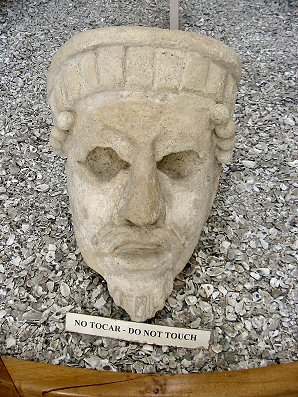
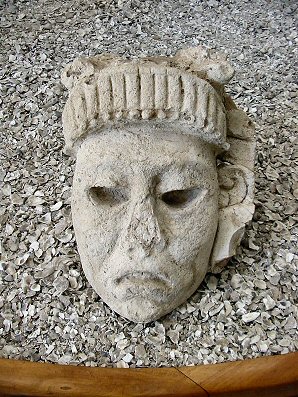

Source
Continued...
So while researching the Comalcalco stone I stumbled upon something that surprised and caught my attention immediately,that was the archeological finding of thousands of bricks that were engraved with inscriptions & languages that were not native to Meso-America at the time and do not belong there as history & other archeological findings in the region would have us believe!
So started my research to dig deeper and what follows is what I've been able to gather & decipher so far ,I will start from the beginning,so as to give some background information on the discovery-

Comalcalco Temple one

Top of Temple one
Comalcalco is a Mayan site surrounded by a rain forest in the Mexican state of Tabasco,It is the only Meso-American city constructed of fired bricks. (I will get to exactly what "fired bricks" are and where the process originated a little later) These ruins contain 372 mounds covering 40 sq. kilometers;so far only four of the 372 mounds have been completely excavated and they have revealed an acropolis,seven temples,two palaces,two structures and 20-30 tombs.
Found within these mounds were thousands of fired bricks that held inscriptions depicting animals,people,plants,houses,temples,ships,letters and sacred symbols but surprisingly many had Mediterranean elements with two even showing elephants!
In the early 1960's a preliminary site survey it was revealed two bricks with inscriptions on them.Afterwards between the years 1975-1978 Mexican archeologist Pancio Salazar,at the time working for the national institute of anthropology & history of Mexico (I.N.A.H) continued more excavations discovering forty six hundred inscribed bricks that were later examined.
Most of the inscriptions were recognizable as Mayan hieroglyphs.but a few turned out to be completely different,causing excitement and speculation.It was not until 1980 after Salazars death that the collection of bricks were photographed & cataloged by archeologist & epigrapher Neil Steede.
Steede showed the photos to professor Barry Fell then leader & founder of 'the epigraphic society'.
Fell went onto publish a series of papers on the subject of the bricks for ESOP (The epigraphic society occasional papers) 'the Comalcalco bricks:part 1,the Roman phase' (published in Vol. 19)
Fell drew attention to what he called "Mason's Marks"out of the forty six hundred bricks examined,fifteen hundred were marked in this way.
What was so interesting about these marks was their striking similarity to Roman mason's marks found on similar bricks in Britain among other places.The Romans used these marks to keep a tally of individual productivity and slaves.
Each of their quarry slaves were required to produce close to two hundred bricks a day,by marking the bricks each slave made with his personal symbol,the slave could prove he was working at full speed.
Also it is believed that The Roman bricks are often stamped with the mark of the legion that supervised their production.
The Romans made use of fired bricks, and the Roman legions, which operated mobile kilns[citation needed], introduced bricks to many parts of the empire. Roman bricks are often stamped with the mark of the legion that supervised their production. The use of bricks in southern and western Germany, for example, can be traced back to traditions already described by the Roman architect Vitruvius.
Source
Here are some examples of the engravings that were found on the bricks-

Mason marks seen on Comalcalco’s bricks (left) strongly resemble those used by Roman masons (right).

Christian motifs common in ancient Europe (top) are similar to motifs at Comalcalco (bottom).
Source [ Fig. 5/16.5.17 ]

Masons' marks from Roman sites (left) and Comalcalco (right) (Fell,Barry 1990)
Source
Additional links concerning 'Mason marks'-
Link
The diagram compares some of the marks found at Comalcalco (on the right) with those found at Roman sites (on the left). The similarities are truly amazing!
Additional links concerning 'Mason marks'-
Link
Some researchers have also claimed that the dimensions of the bricks (more like flat tiles than conventional bricks) and some of the architectural details are more Roman than Mayan. Any Roman connection to the Americas would pre-date Columbus by a thousand years.
Proponents of early contacts from across the Atlantic claim that the Indian Satavahana Dynasty, dating from about 200 BC to 200 AD, had developed extensive trade connections with Rome, and that Brahmi script soon reached Comalcalco.
The technology to make kiln-fired bricks appears to be similar in parts of South East Asia and Comalcalco. As further support, they cite the urn burials found at Comalcalco, which they claim were virtually contemporary with similar burials in India.
Source
Archaeologists working to restore the site discovered that many of the bricks had inscriptions on them. These inscriptions had been invisible, hidden from view, while the bricks had been set in mortar. Dislodged bricks, and those removed for resetting as part of the restoration process, often bore mysterious symbols or inscriptions. In some cases, the brick makers' fingerprints were still clearly visible.
Neil Steede, an archaeologist working on the site, studied almost 5,000 bricks, and photographed the inscriptions he found on about 1,500 of them. Most of the symbols or inscriptions have been interpreted as masons' signs. The really curious thing is that these marks turn out to be virtually identical to the masons' marks used by the Romans, half a world away.
Steede was led to the astonishing conclusion that, "The illustrated bricks of Comalcalco are pieces to a grand puzzle, whose completed, final image may reveal a Roman Christian presence in the Americas a thousand years before the arrival of Columbus." 1
Source
Mediterranean looking ceramic heads found at Comalcalco-



Source
Continued...
Interesting so far. Any pictures of the symbols on the actual bricks?
Yep very interesting indeed
I would also like to see pics of the inscriptions on the fired bricks themselves, if that's possible.
Nice thread mate.
I would also like to see pics of the inscriptions on the fired bricks themselves, if that's possible.
Nice thread mate.
As to the mediterrenean head, most of the Mayan temples have greek patterns, like meanders etc.

There's even a place called "Palacio de las Grecas" - Palaces of the Greeks
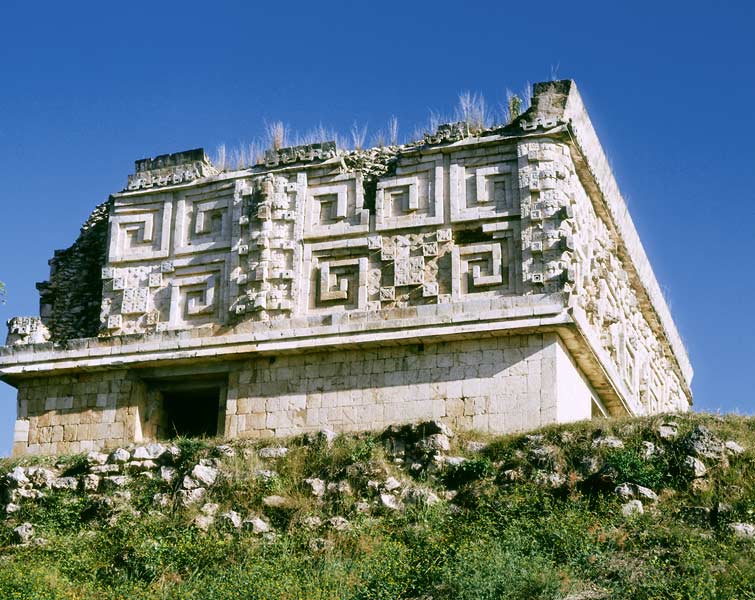
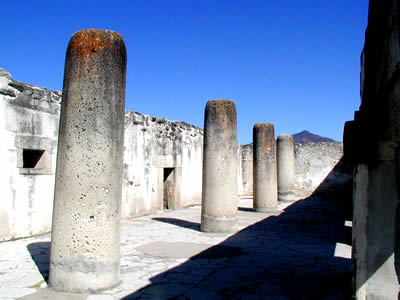
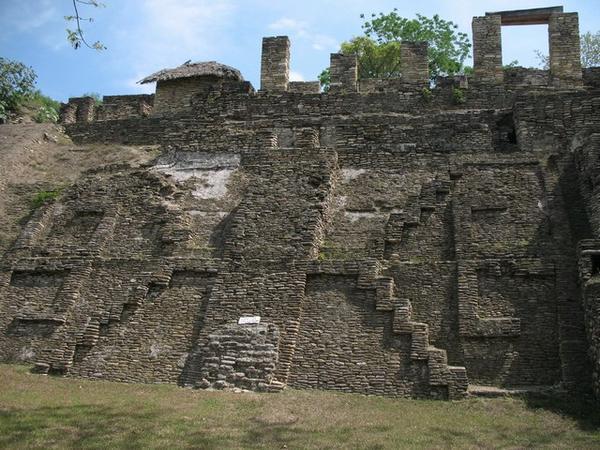
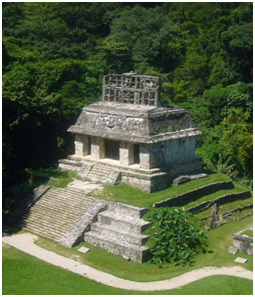

There's even a place called "Palacio de las Grecas" - Palaces of the Greeks




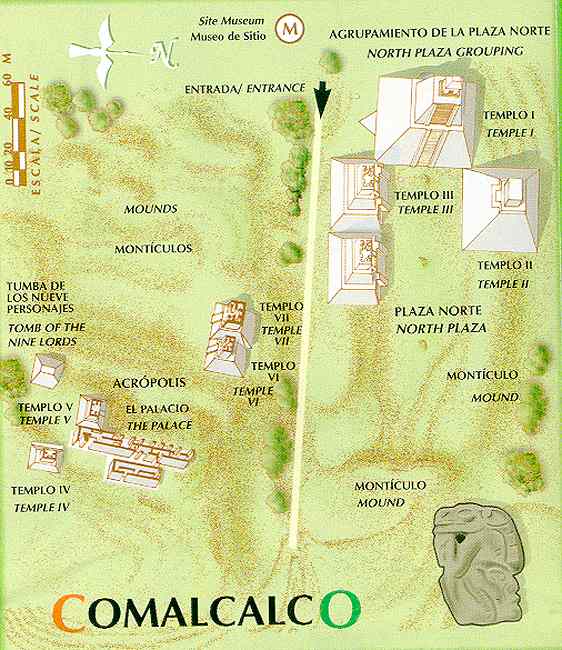
-Comalcalco site map
David Eccott has argued that the technology and perhaps the expertise behind the brick-making at Comalcalco could be part of a tradition stretching back thousands of years. He believes that some of the signs represent a form of ancient script familiar to Mesopotamia and the Indus Valley culture of northern India around 3000 BC.
It is thought to have gradually spread eastwards to China, Sumatra, Easter Island (rongorongo script), and finally Peru, Panama, and Mexico. Examples of the Indus Valley script have been identified both at Comalcalco and on the adobe bricks used to construct the pyramids at Las Ventanas in northwest Peru, dated to between 300 BC and 880 AD. The Indian Satavahana dynasty (c. 200 BC - 200 AD) is known to have had extensive trade connections with Rome.
Source
Additional Photos -
www.delange.org/Comalcalco/Comalcalco
www.delange.org/Comalcalco2/Comalcalco2
www.delange.org/ArchMuseum
Clyde Winters and Neil Steede explored the iconography of the symbols carved in Comalcalco bricks in some detail. Winters, an expert on Olmec script, which pre-dates the rise of the Maya, quickly recognized that one particular brick (T1 452 R16) was very special, since it had both Olmec and Maya script side by side.
Winters translated the Olmec script, and Steede worked on the Maya script, independently, before comparing notes. Their work showed that the two scripts told the same tale. The left hand side was essentially a translation of the right hand side; the brick was bilingual!
Source
Bilingual Mayan-Olmec Text
It is believed that the creators of these unique bricks inscribed onto the surface while still wet, then they were used for construction.Archeologist Neil Steede reported "The inscriptions were never intended to be seen and were covered with mortar" the builders did not wet the brick before applying mortar.This allowed the mortar to bond with the brick and pull away readily"
Why were the bricks made in such a way as to not be seen? it has been theorized that possibly the creatoes wanted to preserve their inscriptions,perhaps realizing that one day the bricks would be unearthed providing a time capsule of sorts.
I suppose this is possible,nothing can be ruled out completely,I find that fascinating none the less,if true.
We can see that Comalcalco is one of the most compelling examples of archeology discoveries that point towards pre-columbian conrtact in history.
I believe this statement summarizes Comalcalco & it's odd,mysterious engraved bricks very well-
Theorists say elsewhere in the Maya region, Roman-style figurines have emerged, and pre-Columbian horse remains have been excavated. Old World parasites and DNA affinities, the blowgun, bark cloth, and paper manufacturing said to have been unearthed at or near Comalcalco add to the mystery according to supporters of the theory.
Of course, mainstream researchers are not quick to embrace the speculation, citing inconclusive and lack of documented evidence. But most will agree that the ruins at Comalcalco are indeed some of the most mystifying pieces of the Mayan puzzle that have been discovered. While much of the architecture is believed akin to structures at nearby Palenque, the art of brick making and many of the design features evident at Comalcalco are singular in the Maya world.
additional interest is the discovery on what is etched or carved into the reverse sides of these bricks, which for all practical purposes are thinner than brick and resemble more of a tile. Made of mortar from crushed shell and rock, the oven baked tiles were often ornamented with drawings, symbols, or even ancient script. In both India and Rome masons would often place their symbol on the back side of tiles, adding support to the argument for Comalcalco's possible connection to oceanic traders.
The Mystery of Comalcalco-Was Columbus a late comer?
links of interest-
DavidPratt.com
dancingfromgenesis.wordpress.com
I look forward to everyone's responses,hope you were able to get something out of it and maybe learned something new! I know it was quite long,sorry for that
edit on 27-11-2011 by PerfectPerception because: (no reason given)
Originally posted by scoobdude
Interesting so far. Any pictures of the symbols on the actual bricks?
Originally posted by Dr Cosma
Yep very interesting indeed
I would also like to see pics of the inscriptions on the fired bricks themselves, if that's possible.
Nice thread mate.
Unfortunately I have been looking and looking...I cannot find anything yet.
a lot of the text from what I have been able to gather is not even available unless you buy the books etc.
I will continue to look! I am eager myself to see,from what I know,Steede who originally photographed them was on record saying a lot of the photos were not of the best quality etc. I believe I saw that somewhere.
If anyone else finds them,I would greatly appreciate it.
here are a few engraved stones,not the ones with the symbols/language on them,from what I could find so far.
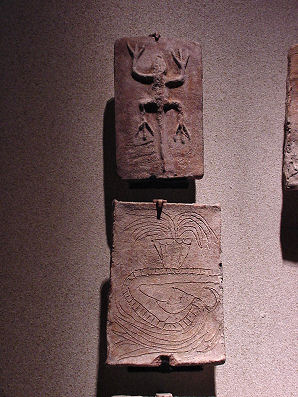

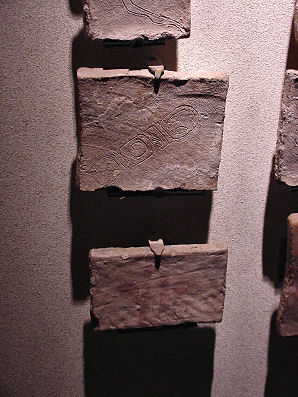
I wanted to add the following,I was unable to add it to the original op because of space-
Source
The Babylonians were believed to be the first,or one the first to use fired brick,it then spread to other regions from there.



I wanted to add the following,I was unable to add it to the original op because of space-
brick has been used as a building material for at least 5,000 years. The first brick was probably made in the Middle East, between the Tigris and Euphrates rivers in what is now Iraq. Lacking the stone their contemporaries in other regions used for permanent structures, early builders here relied on the abundant natural materials to make their sun-baked bricks.
These, however, were of limited use because they lacked durability and could not be used outdoors; exposure to the elements caused them to disintegrate. The Babylonians, who later dominated Mesopotamia, were the first to fire bricks, from which many of their tower-temples were constructed.
From the Middle East the art of brickmaking spread west to what is now Egypt and east to Persia and India. Although the Greeks, having a plentiful supply of stone, did not use much brick, evidence of brick kilns and structures remains throughout the Roman Empire. Read more: www.answers.com...
Source
The Babylonians were believed to be the first,or one the first to use fired brick,it then spread to other regions from there.
edit on
27-11-2011 by PerfectPerception because: (no reason given)
COMALCALCO...........
Comal- Communicate
Calco- Calculate
Amazing how the closer we get to our own self destruction, the more our eyes are opened to what's going to happen.
I think we'll have less than 30 days between the moment of clarity and the perpetual darkness, right after they uncover the link between Egyptians and Mayans.
Comal- Communicate
Calco- Calculate
Amazing how the closer we get to our own self destruction, the more our eyes are opened to what's going to happen.
I think we'll have less than 30 days between the moment of clarity and the perpetual darkness, right after they uncover the link between Egyptians and Mayans.
reply to post by Trublbrwing
Yup well... the word comal can mean a few things. I dont argue the translation, just noting that the use has possibilities. which brings to mind two things for me because I dont know if the origin is Spanish or "native." Could just be mestizo but even that would mean nothing more than a mix of native/spanish, I'm not sure.
A comal is used with heat to make a type of bread, similar to naan, called the tortilla. very old practice considering the people and what they grew/ate. Think corn or wheat. Maybe a sort of hotplate.
BUT... it could also refer to a furnace of sorts, a furnace itself which would be needed in order to make bricks.
Using the example: Go to the comal or go put this on the comal. When you say that, one walks over to the stove because its where the comal would be.
Now you say communicate, I was speculating in a similar thread, that these bricks were used to communicate various things. I didnt really get into the religion, but one can easily see something of that too. Considering comalcalco was suggested to be a port.. I could imagine there being a place to fire bricks. The Aztecs built their city (the present day Mexico City area) out of mud because there was no quarry. They heated mud into bricks. Makes me wonder if they have found very large molcahetes and the brick molds too.
Thanks for the thread Op by the way.
Yup well... the word comal can mean a few things. I dont argue the translation, just noting that the use has possibilities. which brings to mind two things for me because I dont know if the origin is Spanish or "native." Could just be mestizo but even that would mean nothing more than a mix of native/spanish, I'm not sure.
A comal is used with heat to make a type of bread, similar to naan, called the tortilla. very old practice considering the people and what they grew/ate. Think corn or wheat. Maybe a sort of hotplate.
BUT... it could also refer to a furnace of sorts, a furnace itself which would be needed in order to make bricks.
Using the example: Go to the comal or go put this on the comal. When you say that, one walks over to the stove because its where the comal would be.
Now you say communicate, I was speculating in a similar thread, that these bricks were used to communicate various things. I didnt really get into the religion, but one can easily see something of that too. Considering comalcalco was suggested to be a port.. I could imagine there being a place to fire bricks. The Aztecs built their city (the present day Mexico City area) out of mud because there was no quarry. They heated mud into bricks. Makes me wonder if they have found very large molcahetes and the brick molds too.
Thanks for the thread Op by the way.
I love the A&LC threads, when they are well presented, and yours surely is. I also have found many unexplained instances of pre-visitation, so thank
you for providing more information. SnF.
I think maybe the translation of Comalcalco is the house of pans.
en.wikipedia.org...
Maybe because of them baking the bricks.
I'm just wondering if there are actual bricks,and they are being hidden for the sake of archaeology and their egos,or is it all just a big fake.
We may never Know.
Great thread OP.
The literal English translation of "Comalcalco" is "In the house of the comals". A comal is a pan used to prepare tortillas.
en.wikipedia.org...
Maybe because of them baking the bricks.
I'm just wondering if there are actual bricks,and they are being hidden for the sake of archaeology and their egos,or is it all just a big fake.
We may never Know.
Great thread OP.
Originally posted by Nephalim
reply to post by Trublbrwing
Yup well... the word comal can mean a few things. I dont argue the translation, just noting that the use has possibilities. which brings to mind two things for me because I dont know if the origin is Spanish or "native." Could just be mestizo but even that would mean nothing more than a mix of native/spanish, I'm not sure.
A comal is used with heat to make a type of bread, similar to naan, called the tortilla. very old practice considering the people and what they grew/ate. Think corn or wheat. Maybe a sort of hotplate.
BUT... it could also refer to a furnace of sorts, a furnace itself which would be needed in order to make bricks.
Using the example: Go to the comal or go put this on the comal. When you say that, one walks over to the stove because its where the comal would be.
Now you say communicate, I was speculating in a similar thread, that these bricks were used to communicate various things. I didnt really get into the religion, but one can easily see something of that too. Considering comalcalco was suggested to be a port.. I could imagine there being a place to fire bricks. The Aztecs built their city (the present day Mexico City area) out of mud because there was no quarry. They heated mud into bricks. Makes me wonder if they have found very large molcahetes and the brick molds too.
Thanks for the thread Op by the way.
You make some interesting points,thanks for your contribution in my other thread as well,The literal English translation of "Comalcalco" is "In the house of the comals". A comal is a pan used to prepare tortillas,so you were pretty spot on.
Originally posted by Druid42
I love the A&LC threads, when they are well presented, and yours surely is. I also have found many unexplained instances of pre-visitation, so thank you for providing more information. SnF.
Thank you for the kind words.
Originally posted by kdog1982
I think maybe the translation of Comalcalco is the house of pans.
The literal English translation of "Comalcalco" is "In the house of the comals". A comal is a pan used to prepare tortillas.
en.wikipedia.org...
Maybe because of them baking the bricks.
I'm just wondering if there are actual bricks,and they are being hidden for the sake of archaeology and their egos,or is it all just a big fake.
We may never Know.
Great thread OP.
I would love to find out this myself,I will continue to search for anything I can find pertaining to the engraved bricks.
Mark making is probably one of the first things as humans we learn to do before we understand langauge, and it is entirely possible that two
civilisations seperate by a vast ocean and conntinents , that they would create similar looking marks , which have completely different meanings!
For example the mayans use the symbol of the cross and the steps , and the swirl motif to represent the steps to xibalba and to the underworld . and the steps to the crossing between this world and the afterlife , the cross being the galactic cross and the center of the milky way !
Where as the romans , may have used the cross to represent early christianity !
For example the mayans use the symbol of the cross and the steps , and the swirl motif to represent the steps to xibalba and to the underworld . and the steps to the crossing between this world and the afterlife , the cross being the galactic cross and the center of the milky way !
Where as the romans , may have used the cross to represent early christianity !
This seemed interesting at first, but that Neil Steede guy does not seem like a particularly reputable source. If he has 1500 photos of anomalous
Mason's marks in Comalcalco, he should really have published them online. I can't find any by him, nor any convincing photos by anyone else. All the
references to the glyphs on these bricks seem to go back to him.
Here is a site by Neil Steede where he claims carvings at Palenque contain elaborate depictions of Jesus Christ (and also a picture of him standing by a large chicken).
www.greatlakesrestorationbranches.org...
However, I found another site that has a few photos of some crosses and jagged lines from Comalcalco which are somewhat similar to the Mason's marks he depicted. www.pbase.com... There could always be more.
A problem with interpreting Mason's marks is that it is not easy to tell if they were carved to communicate something important or not. These symbols are pretty basic and could quite easily have no more purpose than identification or accounting of a labourer's work.
On the other hand, maybe their simplicity offers power as type of fundamental universal communication? Triangles, circles, intersections etc all refer in some way to the underlying math of the universe.
This is a bit off topic, but I thought I'd add it as I can't be bothered to write a thread about it and this Comalcalco one is not looking in good shape.
London, England's streets are not paved with gold, but the curb stones are certainly highly decorated in Mason's marks. afaik these stones are a couple of hundred years old in many places.
Theobald's Road:
Soho:
Here is a site by Neil Steede where he claims carvings at Palenque contain elaborate depictions of Jesus Christ (and also a picture of him standing by a large chicken).
www.greatlakesrestorationbranches.org...
However, I found another site that has a few photos of some crosses and jagged lines from Comalcalco which are somewhat similar to the Mason's marks he depicted. www.pbase.com... There could always be more.
A problem with interpreting Mason's marks is that it is not easy to tell if they were carved to communicate something important or not. These symbols are pretty basic and could quite easily have no more purpose than identification or accounting of a labourer's work.
On the other hand, maybe their simplicity offers power as type of fundamental universal communication? Triangles, circles, intersections etc all refer in some way to the underlying math of the universe.
This is a bit off topic, but I thought I'd add it as I can't be bothered to write a thread about it and this Comalcalco one is not looking in good shape.
London, England's streets are not paved with gold, but the curb stones are certainly highly decorated in Mason's marks. afaik these stones are a couple of hundred years old in many places.
Theobald's Road:
Soho:
edit on 28-11-2011 by yampa because: (no reason given)
Originally posted by sapien82
Mark making is probably one of the first things as humans we learn to do before we understand langauge, and it is entirely possible that two civilisations seperate by a vast ocean and conntinents , that they would create similar looking marks , which have completely different meanings!
For example the mayans use the symbol of the cross and the steps , and the swirl motif to represent the steps to xibalba and to the underworld . and the steps to the crossing between this world and the afterlife , the cross being the galactic cross and the center of the milky way !
Where as the romans , may have used the cross to represent early christianity !
Actually, the cross has been a mystical symbol in Egypt long before Christianity...
I'm afraid I never post anything sufficiently interesting enough to garner much response, but as good or as bad as this subject may be (fellow above
with pictures of London Makers marks), it has piqued my curiosity greatly. My wife has decided we are going to vacation there and do some looking and
investigating.
One of the mysteries of ancient marks is obviously the meanings. I'm thinking (and this isn't a put down) that maybe the folks who think this is all Atlantis or Lemuria, ought to give it a chance to be legitimized first. If it's not legitimate, then try to go back to whatever Mu, Atlantis, etc, may have been.
The reason I say the above is that too often things that are found are attributed to a long lost, never to be found civilization, or to aliens from planet X. Seems like we are never ready to give the human civilizations or race, it's due. There is always the possibility (be it however slim) that we could have done it ourselves.
And for what it is worth, I wouldn't be at all surprised, if we ever get to the bottom and find all the answers, that there was the possibility of global societies that interacted much like today, at some point in the past. Although, it seems a little strange that there isn't more "written or pictorial" topical evidence of it.
A Star and Flag to the OP and some of the following posts. Thank you so much for this information and the time you took to create clear and concise posts, all.
Saintly Unca Dan
One of the mysteries of ancient marks is obviously the meanings. I'm thinking (and this isn't a put down) that maybe the folks who think this is all Atlantis or Lemuria, ought to give it a chance to be legitimized first. If it's not legitimate, then try to go back to whatever Mu, Atlantis, etc, may have been.
The reason I say the above is that too often things that are found are attributed to a long lost, never to be found civilization, or to aliens from planet X. Seems like we are never ready to give the human civilizations or race, it's due. There is always the possibility (be it however slim) that we could have done it ourselves.
And for what it is worth, I wouldn't be at all surprised, if we ever get to the bottom and find all the answers, that there was the possibility of global societies that interacted much like today, at some point in the past. Although, it seems a little strange that there isn't more "written or pictorial" topical evidence of it.
A Star and Flag to the OP and some of the following posts. Thank you so much for this information and the time you took to create clear and concise posts, all.
Saintly Unca Dan
I recognize the first symbols. It looks very similiar to wiccan runic, which came from native american's.
reply to post by yampa
thanks for responding.
I have looked,and looked myself for the pictures of the engravings...that does not mean this thread is obsolete or as you stated " in bad shape" I will be waiting for you to compile a thread and do better.
At the end of the day,Comalcalco being the only Olmec/Mayan or central American site to be found using fired bricks is fascinating alone.
did you see the Mediterranean looking ceramic heads? what about them?
thanks for responding.
I have looked,and looked myself for the pictures of the engravings...that does not mean this thread is obsolete or as you stated " in bad shape" I will be waiting for you to compile a thread and do better.
At the end of the day,Comalcalco being the only Olmec/Mayan or central American site to be found using fired bricks is fascinating alone.
did you see the Mediterranean looking ceramic heads? what about them?
edit on 28-11-2011 by PerfectPerception because: (no reason given)
new topics
-
Of course it was DEI
Dissecting Disinformation: 8 hours ago -
2nd Day Thanksgiving!...(leftovers!!)
General Chit Chat: 10 hours ago
top topics
-
Of course it was DEI
Dissecting Disinformation: 8 hours ago, 6 flags -
2nd Day Thanksgiving!...(leftovers!!)
General Chit Chat: 10 hours ago, 3 flags
active topics
-
I thought Trump was the existential threat?
World War Three • 124 • : andy06shake -
Mass UAP events. DC. Machester Airport, UFOs over sub base in CT, Nuke bases.
Aliens and UFOs • 26 • : CosmicFocus -
Unidentified Flying Objects Over U.S. Military Bases in Northeast UK, as of roughly 11 a.m. CST.
Aliens and UFOs • 34 • : bastion -
Post A Funny (T&C Friendly) Pic Part IV: The LOL awakens!
General Chit Chat • 7850 • : KrustyKrab -
Of course it was DEI
Dissecting Disinformation • 10 • : Dalamax -
-@TH3WH17ERABB17- -Q- ---TIME TO SHOW THE WORLD--- -Part- --44--
Dissecting Disinformation • 3417 • : brewtiger123 -
2nd Day Thanksgiving!...(leftovers!!)
General Chit Chat • 6 • : DontTreadOnMe -
New Disney Star Wars Films Failing Test of Time?
Movies • 18 • : Popoll -
The Party of Peace - Trump Cabinet Picks Targeted with Death Threats
US Political Madness • 51 • : RazorV66 -
Results of the use of the Oreshnik missile system in Dnepropetrovsk
World War Three • 263 • : DontTreadOnMe


